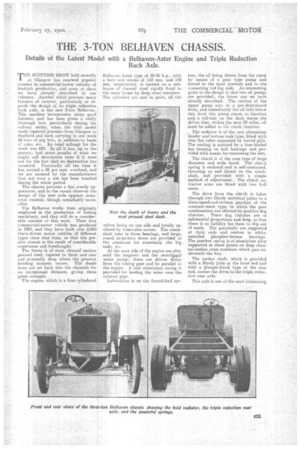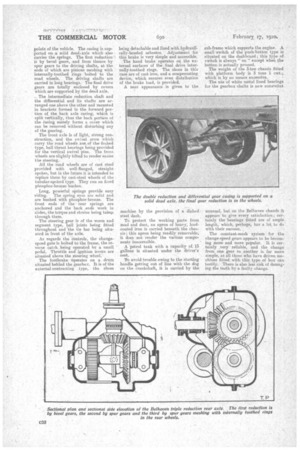THE 3-TON BELHAVEN CHASSIS.
Page 19

Page 20

If you've noticed an error in this article please click here to report it so we can fix it.
Details of the Latest Model with a Belhaven-Aster Engine and Triple Reduction Back Axle.
T"SCOTTISH SHOW held recently at Glasgow has renewed popular interest in commercial-motor vehicles of Scottish production, and some of these we have already described in our columns. Another which presents many features of interest, particularly as regards the design of its triple reduction back axle, is the new 3-ton Belhaven. This machine incorporates many good features, and has been given a really thorough test, particularly during the railway strike, when the trial model made repeated journeys from Glasgow to Sheffield and back carrying in one week 60 tons of pig iron, in addition to loads of coke, etc. Its total mileage for the week Was 600. In all it has, up to the . present, had seven months of what we might call destructive tests if it were not for the fact that no destruction has occurred. Practically all the time it has carried a 50 per cent, overload, and we are assured by the manufacturers that not even a nut has been touched during the whole period. The chassis presents a fine' sturdy appearance, and to the casual observer the design or the rear axle appears somewhat unusual, though remarkably -accessible.
The Belhaven works were originally employed in the production of baking machinery, and they still do a considerable amount of this work. Their first commercial-motor vehicle was. produced in 1908., and they have built over 2,000 chain-driven motor vehicles of differenttypes since that time, so that the present chassis is the result of considerable experience and forethought.
The frame•is of stout channel section pressed steel, tapered to front and rear and unusually deep where the greatest bending moment occurs. The dumb irons are set .back into the channels for an exceptional distance, giving them great strength.
The engine, which is C four-cylindered
BeihavereAster type. of 30-35 h.p., with a -bore and stroke of 110 mm. and 140 mm. respectively, is carried on a subframe of channel steel rigidly fixed to the main frame by deep cross -members. The cylinders are castin pairs, all the
valves being on one side and totally enclosed by removable covers. The crankshaft runs in three hearings, and large, round inspection doors are provided in the crankcase for examining the big ends, etc.
At the near side of the engine are situated the magneto and the centri4fgal water pump; these are driven direct fromthe timing gear and lie parallel to the engine. A neat aluminium casing is provided for leading the wires over the exhaust pipe.
Lubrication is on the forced-feed sys tern, the oil being drawn from the sump by means o/ a gear type pump and forced to the main journals and to the connecting rod big ends. An interesting point in the design is that two oil pumps are provided; the 'lower one we have already described. The suction of the upper pump acts at a pre-determined level, and immediately the oil falls below this level this pump-ceases to function and a tell-tale on the dash warns the driver that, within the next 20 miles, oil must be added to the crank chamber.
, The radiator is of the cast aluminium header and bottom tank type, fitted with thin flat tubes separated by waved gills. The cooling is assisted by a four-bladed fan running on ball bearings and provided with means for. tensioning the belt.
The clutch is of the cone type of large diameter and wide faced. The clutch spring is enclosed and is self-contained, throwing no end thrust on the crankshaft, and provided with a simple method of adjustment. The clutch extractor armsare fitted with two ball races.
The drive from the clutch, is taken through two Hardy universal joints to a three-speed-and-reverse gearbox of the constant-mesh type, in which the gear combinations-are effected by positive dog clutches. These dog clutches are of substantial proportions and deep, so that there is no liability fox them to slip out of mesh. The gearshafts are supported at their ends and centres in white metalled phosphor-bronze bearings. The gearbox casing is ef aluminium alloy supported at three points on deep channel-section cross members which pass -underneath the box.
The cardan shaft, which is provided with a Hardy joint at the front end and with a plunger-block type at the rear end, carries the drive to the triple reduction rear axle.
This axle is one of the most interesting points of the vehicle. The casing is supported on ,as solid dead axle which also carries the springs. The first reduction is by bevel gears, and from thence by spur gears to the driving shafts, at the ends of which are pinions meshing with internally-toothed rings bolted to the road wheels. The driving shafts are carried in long bearings. The final drive gears are totally enclosed by covers which are supported by the dead axle.
. The intermediate reduction shaft and the differential and its shafts are arranged one above the other and mounted in brackets formed in the forward portion of the back axle casing, which is split vertically, thus the back portion of the Casing merely forms a cover which can be removed without disturbing any of the gearing.
The front axle is of light, strong construction, and the swivel arni.s which carry the road wheels .ave, of the hydsed type, ball thrust bearings being provided for the vertical swivel pins. The from; wheels are slightly tilted to render easier the steering.
All the road wheels are of cast steel provided with well-flanged, straight spokes, but in the future it is intended to replace these by east-steel wheels of the tubular-spoked type. They run on fixed phosphor-bronze bushes.
Long, powerful springs provide easy riding. The spring eyes are solid and are bushed with phosphor-bronze. The front ends of the rear springs are anchored and the back ends work in slides, the torque and strains being talmi through them.
The steering gear is of the worm and segment type, ball joints being fitted throughout and the tie bar being situated in front of the axle.
As regards the controls' the changespeed gate is bolted to the frame, the reverse catch being operated by a small pedal. Throttle and ignition levers are situated above the steering wheel.
The footbrake operates on a drum situated behind the gearbox. It is of the external-contracting type, the shoes being detachable and lined with hydraulically-bonded asbestos. Adjustment for this brake is very simple and accessible.
The hand brake operates on the external surfaces of the . final drive internally-toothed rings. The shoes in this ease are of cast iron, and a compensating device, which ensures even distribution of the brake load, is provided. A neat appearance is given to the machine by the provision of a dished steel dash.
To protect the working parts from mud and dust, an apron of heavy, lead. coated iron is carried beneath the chassis; this apron being readily removable, it does not resider the various components inaccessible.
A petrol tank with a capacity of. 15 gallons is situated under the driver's seat.
To avoid trouble owing to the starting handle getting out of line with the dog on the crankshaft, it is carried by the sub-frame which supports the engine. A • small switch of the push-button type is situated on the dashboard; this type of switch is always " on " except when the button is actually pressed.
The weight of the 3-ton chassis fitted with platform body is 3 tons 1 cwt., which is by no means excessive. The use of white metal lined bearings for the gearbox shafts is now somewhat
unusual, but on the Belhaven chassis it appears to give every satisfaction; cer-, tainly the bearings fitted are of ample length, which, perhaps, has a lot., to do with their success.
The constant-mesh system for the change-speed gears appears to be becoming more and more popular. It is certainly very reliable, and the change from one gear to another is far more simple, as all those who have driven machines fitted with this type, of box can testify. There is also less risk of damaging the teeth by a faulty change.




























